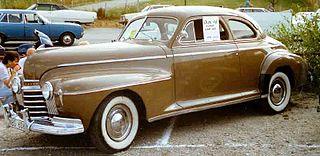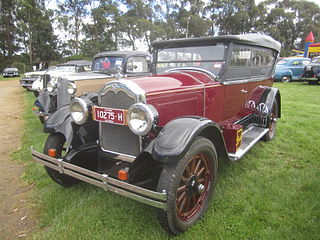Du Pont Motors was founded by E. Paul du Pont to produce marine engines for the Allied nations during World War I. After the war, Du Pont Motors produced extremely high-end automobiles. The cars were manufactured in Wilmington, Delaware.

The Series 60 "Special" is a full-size car made by Oldsmobile from the 1939 through the 1948 model years. It was their entry-level model using the GM "A" body platform, giving Oldsmobile an entry level product with more standard features that would be optional on Chevrolet and Pontiac vehicles using the same platform. Initially, the engine size used was the company's flat head 6 cylinder, while senior models would use the flat head 8 cylinder. For marketing purposes, the Oldsmobile Series 60, or the Oldsmobile 66, took advantage of the national highway U.S. Route 66 established in 1926.It was with this generation that all GM vehicles experienced increased width dimensions to accommodate three passengers on the front bench seat and an additional three passengers on rear bench seat installed vehicles. This was accomplished with the deletion of running board thereby adding additional room inside the passenger compartment and upgrading the floor mounted gearshift to a steering column installed transmission gear selector for the Hydramatic automatic transmission.

The Lincoln Custom is a custom limousine and long-wheelbase touring sedan that was built by Lincoln in 1941 and 1942 and the lower level series Lincoln produced in 1955. Initially it was a replacement for the previous Model K Lincolns and earlier luxury cars of the 1920s and 1930s. The body work for the Custom was provided by the factory and came in one appearance and abandoned the previous Model L and Model K of years past of manufacturing only the chassis then a long list of coachbuilders would provide coachwork to the customer's preference. In later years it was simply the base model series.

The Packard Station Sedan was a pseudo luxury station wagon model produced by the Packard Motor Car Company of Detroit, Michigan between 1948 and 1950, using the Packard Eight platform. By offering the Station Sedan Packard could market a vehicle with station wagon attributes, but without the investment cost associated with a complete station wagon development program.

The Packard Twelfth Series One-Twenty is an automobile produced by the Packard Motor Car Company of Detroit, Michigan, from 1935 to 1937 and from 1939 through the 1941 model years. The One-Twenty model designation was derived from the wheelbase, and it was replaced by the Packard 200.

The Lincoln K series is a luxury vehicle that was produced by the Lincoln Motor Company. The second motor line produced by the company, the Model K was developed from the Model L, including a modernized chassis on a longer wheelbase. In 1931, Lincoln introduced a V-12 engine, becoming a feature of the company for nearly 20 years.

The Packard Custom Super Eight One-Eighty was introduced for the 1940 model year by the Packard Motor Car Company to replace the discontinued Packard Twelve as their top-of-the-line luxury model. The car was derived from the Packard Super Eight One-Sixty with which it shared the complete running gear including the in-line eight-cylinder, 356-cubic-inch (5,830 cc) engine that developed 160 horsepower. It was advertised as the most powerful eight-cylinder engine offered by any automobile manufacturer in 1940.. It was complemented and gradually replaced by the more modern looking and mid-level Packard Clipper in 1941 and integrated into the Super Eight after the war.

Marquette was a brand used on several different automobiles, most recently on Buick's companion make for the 1929, 1930 and 1931 model years.

The Packard Ninth Series Light Eight Model 900 was an automobile model produced by the Packard Motor Car Company of Detroit, Michigan only during model year 1932. The Light Eight was planned as a new entry model, building off the 1928 Packard Six. It competed in the upper middle-class with makes like GM's Companion Brand LaSalle, Marquette and Chrysler's DeSoto, and the top-level products from Studebaker, Hudson, and Nash. The marketing objective was to add a new market segment for Packard during the depression.

The Buick Master Six Series 40 and Series 50, based on the wheelbase used, was an automobile built by Buick from 1925 to 1928 and shared the GM B platform with the Oldsmobile Model 30. Previously, the company manufactured the Buick Six that used the overhead valve six-cylinder 242 cu in (4.0 L) engine in their high-end cars, and the Buick Four for smaller, less-expensive cars. Starting with 1918, they dropped the four-cylinder engine and designed a small six, which they called the Buick Standard Six, to replace that end of the market. They coined the name "Master Six" for the high-end cars, now powered by the 255 cu in (4.2 L) engine released the year before. The yearly changes were a result of a new business philosophy called planned obsolescence
The Lyons-Knight was an American automobile manufactured from 1913 until 1915 in Indianapolis, Indiana by three brothers James W., William P. and George W. Lyons by purchasing the previous Atlas Engine Works and reorganizing the company as the Lyons-Atlas Company. Previously, the Atlas Company manufactured two-stroke gasoline and diesel engines that developed a line of gasoline engines using the Knight sleeve valve design. Starting in 1913, the Lyons-Knight Model K offered a four-cylinder engine that produced 50 BHP and was installed in a choice of five or seven passenger touring car, sedan, or berline using a 130" wheelbase. Prices started at USD$2,900 for the five passenger touring sedan while the berline sedan was USD$4,300. For 1915 only, a six-cylinder engine was offered with the same wheelbase in either a five or seven passenger touring sedan for USD$3,200 along with the previous four cylinder engine, and a limousine and roadster before operations ended soon after when Knox resigned from the company in August.

The Packard Motor Car Company introduced their first four-cylinder engine in 1903 initially as a top level car along with the Packard Model F. It was their only automobile offered and exclusively used a four-cylinder engine from 1903 until 1912 and established Packard as a luxury car maker, and was replaced by the 1913 Packard Six.

The Packard Eight was a luxury automobile produced by Packard between 1924 and 1936, and was an all new platform that took the top market position from the earlier Packard Twin Six which was first introduced in 1916. When it was introduced, it was designated as the Senior Packard until the company ended in the late 1950s.

The Packard Twelve was a range of V12-engined luxury automobiles built by the Packard Motor Car Company in Detroit, Michigan. The car was built from model year 1916 until 1923, then it returned 1933 until 1939. As a sign of changing times, the majority of second generation Packard Twelves received standard bodywork, with custom bodywork gradually losing favor. Many of the custom cars were actually only "semi-customs", with Dietrich assembling Packard-made bodies with special touches. The first generation engine was modified for military use and became the Packard 1A-2500 which began usage in 1924.

The Model S was the first four-seat passenger car produced by Oldsmobile in 1906, offered as a larger alternative to the Model R Curved Dash runabout that appeared in 1901. The advertised price was $2,250. It was Oldsmobile's first four cylinder car and took the top level marketing position above the Model L and the entry-level Model R. It was one of the last independently developed products before they joined General Motors in 1908, and competed against Buick, Ford and other automakers at the time. It was built at the Oldsmobile factory in Detroit and developed by Frederick and Angus Smith, whose father Samuel L. Smith was the primary investor, and R. E. Olds had left the company due to an argument with Oldsmobile Board of Directors.
The Model M was a four-seat passenger car produced by Oldsmobile in 1908, offered as a mid-range alternative to the Model R Curved Dash runabout that appeared in 1901, replacing the Model A. It was the junior sedan to the first six-cylinder sedan called the Oldsmobile Model Z also introduced in 1908, but was larger than the Oldsmobile Model X.

The Oldsmobile Six, also known as the Model 53, 54 and 55 (1913-1915) then a brief cancellation until it reappeared as the Model 37, 37A and 37B (1917-1921) was a top level sedan along with the Oldsmobile Series 40 junior vehicle produced by GM's Oldsmobile Division and was manufactured at Lansing Car Assembly in Lansing, Michigan. It replaced the Series 28 also known as the "Oldsmobile Autocrat" and was replaced by the Oldsmobile Model 30 in 1927, and shared wheelbases with the Buick Six.It continued to use the T-head engine for two years. The various bodystyles were supplied by Fisher Body of Detroit, MI. It competed with the Chevrolet Series C Classic Six as Chevrolet was an independent company before becoming a division in 1917. Oldsmobile also shared technology with GMC for commercial and industrial products.
The Oldsmobile Series 28, also known as the Autocrat, was a mid-level four seat passenger car produced by GM's Oldsmobile Division for 1911 and 1912. It was based on the top-level Oldsmobile Limited while using a four-cylinder engine, and was manufactured in Lansing, Michigan.

The Oldsmobile Limited was an top-level passenger car produced by GM's Oldsmobile Division in 1910, offered as an upgraded replacement to the Oldsmobile Model Z when it was discontinued in 1909. The Oldsmobile Limited was very large and expensive in comparison to vehicles offered by competitors, and was manufactured in Lansing, Michigan. It was the senior model to the mid-level Oldsmobile Autocrat of which it shared much of its technology while the Autocrat was smaller, and was replaced by the Oldsmobile Light Eight. It was also much larger than GM's lop level brand, the Cadillac Model Thirty which only had a four cylinder engine, and the Buick Model 10 which made the Limited the most expensive vehicle GM offered at the time.

The Packard Six was a series of luxury automobiles built over several generations by Packard from 1913 until 1947. The name was originally used to describe the car in general terms, while Series numbers were initially used and changed every year to denote wheelbases, then the number classification changed as market conditions changed so as to keep competitive with other luxury brands.

















